| |
Ben Heckendorn's NESp - The
Continued Saga! |
|
Sure enough, the Super Joy Fun Stick Player Mech Game Player Game had a
"NES on a Chip" in it. Later on I tested it and found it
only drew 50mA of power to run. That's pretty low, a hacked-up Atari
2600 is usually 250-300mA. The next step was to change
its 60-pin Japanese Famicom connector to the 72 pin American NES, so I
could use domestic cartridges. To keep the portable unit small I
couldn't simply use an adapter (such as you need with the Game Axe)
because it would add length to the cartridge area. Therefore, I elected
to build my own adapter using a 72 pin card edge connector and wiring it
directly to the board of the pirate NES.
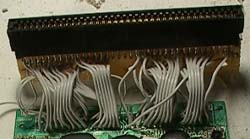
At the top, the 72 pin American NES cartridge
slot, at the bottom, the Famicom board. Note the empty connections in
the middle...
My research taught me the
differences between a Famicom and a NES cartridge slot. The NES has all
the same pinouts as the Famicom plus about 14 extras. 4 of those are
used for the NES to access the "Lockout" chip on the game
cartridge. (the Famicom did not need a Lockout chip to run) The other 10
or so allow the cartridge direct access to the Mystery Expansion Port on
the bottom of the NES.
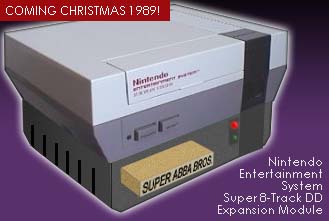
A potential add-on?
Nintendo must have given up
the ghost with their expansion port, for if you look at later model NES
carts, the pins that go to that port aren't even on the cartridges!
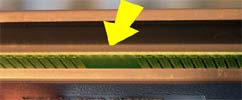
Once I had the adapter
wired, I tried it out. Of course it didn't work, so I had to find a way
to test my connections. I needed a Famicom game that went through an
adapter, then into my adapter, then into the Famicom clone board.
Not wanting to spend much on an authentic fake adapter import, I turned
to the next best thing!
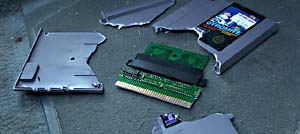
Smashed-open Gyromite
cartridges! Yes, it's true. Inside some of the VERY oldest NES
cartridges is the Famicom ROM PCB of the game, which goes into a Famicom-to-NES
converter, and then the standard NES connector. I don't know if Nintendo
was trying to use excess Famicom inventory when they made their jump to
the States, but it's a great way to find adapters now!
(Look for specially UN-marked
cartridges of old games like Gyromite, Stack-Um, Hogan's Alley or
Excitebike. Compare the weight of the cart with another NES cart laying
on the shelf, say, Deadly Towers. If the old NES cart feels heavier /
off-balance, there's a good chance it contains an adapter! Smash it open
and enjoy!)
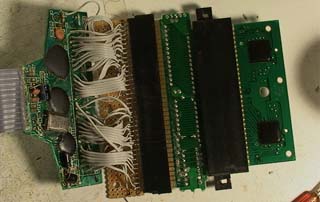
To the best of my knowledge, the World's First "Famicom-to-NES-to-Famicom
adapter" (Patent Pending)
Using my new super-adapter I
realized I had two wires switched around. Ahem. I fixed it and VIOLA!
The thing ran! I was running regular old plain jane NES carts on this
whacked-out import fake Famicom thing! The problem was so simple, I
could justify the 2 bucks I spent on the Gyromite cartridge. Now only if
the ROBOT had a use...
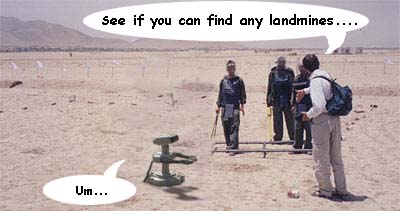
But there was trouble in
paradise. Even though the unit itself was working, I could not get the
controller to work. My plan was to use the guts of a standard NES pad in
my portable. Even though I had found the correct pins to connect a NES
pad to the Famicom, it wasn't working! I tried variation after
variation, beer after beer, but it just wouldn't take the gamepad
signals!
The original Super Joy Fun
Stick Player Mech Game Player Game had its own built-in joypad (complete
with backwards A & B buttons). I wondered if a regular NES pad would
even work at all with this thing. Heartbroken and in despair (well not
that bad but it makes for good prose) I once again let the project rest
while I worked on other things...
Will Ben give up? Will the "Super Joy Fun Stick Player Mech Game
Player Game" get the best of him? Find out!

|